Mar 2017
In a more sharply divided media landscape than ever before, is the truth really out there anymore?
03/28/17 09:18 AM

By ED BARK
@unclebarkycom on Twitter
True or false: The truth is out there.
Answer: Basically false these days. This tagline might still fit within the confines of Fox’s The X-Files. But in the real world, it unfortunately must be altered to “The truths are out there.”
Your friendly content provider has lamented for years that there’s just too much media out there. Consequently, there’s increasingly no “there” there. In a severely divided country, far too many consumers now get their “news” from television networks, websites or newspapers that mirror or reinforce their opinions. I’m on the record nationally about this, courtesy of a transcript from PBS’ September 2003 edition of Flashpoints USA. The host was Bryant Gumbel and the co-panelists were NPR host Brooke Gladstone and former TV Guide reporter Max Robins. It was before Twitter took hold and Facebook devolved into a part-time war zone.
“I think you can make the case that there’s almost too much news out there right now,” I said. “It’s not the same as in, say, the fast food industry. If you’ve got McDonald’s, Burger King, Wendy’s all competing, you get lower food prices that generally benefit the consumer. With all these news channels out there now, especially the three cable channels, the competition, I don’t think, leads to better news. It leads to a lot more screaming . . . A lot of times, the old definition of news doesn’t apply at all anymore. I think it’s mainly, take one story a day, and flog it to death, and go from one personality-driven show to another in many cases.”
Well, we hadn’t seen nothin’ yet. Fueled by Donald Trump’s election and subsequent Twitter-pronged presidency, the three cable news networks and myriad websites have taken sides as never before.
The President’s frequent “fake news” diatribes and infamous “enemy of the people” tweet have never included Fox News Channel, where he’s lately done the majority of his interviews while also parroting whatever the network says is news -- even if it’s from a commentator citing the unnamed sources that Trump claims to despise. In the horse race to curry his favor, FNC’s Sean Hannity is a veritable Secretariat, trailed by Fox and Friends and Tucker Carlson in that order.
MSNBC, after initially struggling to gain traction as a more or less middle of the road news outlet, gave up that game plan long ago and now is the anti-Trump network at the other end of the cable news teeter totter. In the win, place and show results, Rachel Maddow continues to lead colleague Lawrence O’Donnell by perhaps a length or two. Former Trump pals Joe Scarborough and Mika Brzezinski come in third while continuing to assail him on Morning Joe.
CNN, which has taken the brunt of the President’s “fake news” slams, began the presidential campaign as a compliant disseminator of all things Trump. The network is still comparatively balanced compared to its cable news adversaries. After all, its payroll includes Trump defenders Jeffrey Lord, Kayleigh McEnany and, lately, Jason Miller, who replaced Corey Lewandowski.
But led by Don Lemon and Jake Tapper, CNN also has aggressively and bluntly challenged the President’s declarations of what’s true and what isn’t. You can only take his lashings for so long before, in a sense, becoming part of The Resistance. Lemon and Tapper lately can be seen as both truth-tellers and ax-grinders in CNN’s determined effort to growl in defiance after rolling over for Trump during the early stages of the presidential campaign.
Even the two Sunday morning media analysis shows, CNN’s Reliable Sources and FNC’s Media Buzz, can’t be relied on to be faithfully impartial anymore. Reliable Sources host Brian Stelter, who replaced Howard Kurtz, is easily the more balanced of the two. But he’s now regularly on the Trump attack while Kurtz and his Media Buzz program clearly have a conservative slant. Comparing the two programs on a weekly basis can be both instructive and dispiriting.
Things came further to a head earlier this week, when Hannity and Ted Koppel clashed on CBS Sunday Morning. “Do you think we’re bad for America? You think I’m bad for America?” Hannity asked.
“Yeah,” Koppel said drily, continuing after Hannity interjected. “You know why? Because you’re very good at what you do . . . Because you have attracted people who are determined that ideology is more important than facts.”
On Monday’s Hannity, the host of course fired back in a top-of-the-show segment titled “Edited Fake News.” Only about a minute of his 45-minute sit-down with Koppel made the air, he said, terming the former Nightline anchor a “hypocrite” who feels free to express his own opinions but doesn’t want to hear others.
“I was just used as a prop” to further Koppel’s pre-determined narrative, Hannity charged.
His guest for the segment, conservative commentator Michelle Malkin, of course agreed with Hannity, lumping Koppel among “these walking dead liberal media decrepit elitists.” Furthermore, Koppel is “this ancient gatekeeper” in Malkin’s view. And his brand of journalism is dead.
Earlier, on FNC’s The O’Reilly Factor, guest Brit Hume (a former colleague of Koppel’s at ABC News), said he assumed that Koppel also would similarly find fault with MSNBC’s decidedly left-leaning approach. In fact he has. In a 2010 guest column for The Washington Post, Koppel wrote, “The commercial success of both Fox News and MSNBC is a source of nonpartisan sadness for me.”
I haven’t even gotten into all of the partisan media websites that have sprung up since that now far-off 2003 Flashpoints USA program. This is, after all, primarily a TV website.
Suffice it to say, though, that 1996 turned out to be an arguably dark year for American journalism. It’s the year when both FNC and MSNBC were launched. A little over two decades later, are we better off now than we were then?
From this perspective, that’s gonna be a pretty big no.
Note to readers: This piece, in shorter form, first appeared as my regular column for Katy Trail Weekly.
Email comments or questions to: unclebarky@verizon.net
Serving more time and resurrecting the dead via Fox's Prison Break
03/27/17 10:10 AM
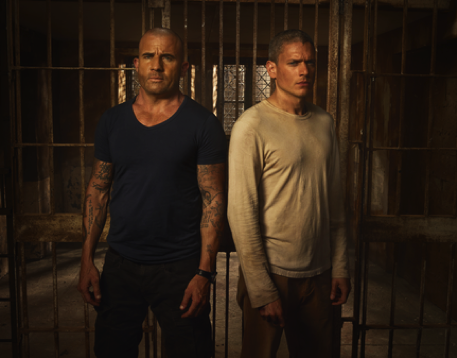
Brothers Linc and Michael again belly up to the bars in Prison Break. Fox photo
Premiering: Tuesday, April 4th at 8 p.m. (central) on Fox
Starring: Dominic Purcell, Wentworth Miller, Sarah Wayne Callies, Robert Knepper, Rockmond Dunbar, Amaury Nolasco, Mark Feuerstein, Paul Adelstein, Inbar Lavi
Produced by: Paul T. Scheuring, Vaun Wilmott, Michael Horowitz, Dawn Olmstead, Nelson McCormick, Marty Adelstein, Neal Moritz, Brett Ratner
By ED BARK
@unclebarkycom on Twitter
It really would be best for all concerned to never ever believe that a prominent TV character is truly dead.
Who was it that said, “I am the resurrection and the life?” Just thinking aloud while noting that Fox is the latest network to play a lower case god.
Seven years ago, Prison Break’s soulful Michael Scofield (Wentworth Miller) presumably was laid to rest after sacrificing himself for the greater good of his new wife, Sara Tancredi (Sarah Wayne Callies), and their unborn son. He left behind a heart-tugging video that was played at the close of what was supposed to be the series’ final act. Nope, it wasn’t. So here comes a nine-episode return, starting on Tuesday, April 4th. Fox sent the first four episodes while also imploring, “Specifically in regards to Episode Four, we ask that you DO NOT reveal the details of the prison escape sequence, as well as major character deaths and a villain reveal.”
Don’t worry. Your secrets are safe. Except does anyone really die in Prison Break? And I deduced the “villain reveal” well before Episode Four. Other vigilant viewers might see it coming as well.
Prison Break resumes with the scummy Theodore “T-Bag” Bagwell (Robert Knepper) somehow being released from the Fox River Penitentiary, in part because he’s been a model prisoner. It’s hard to imagine T-Bag being a model anything, but Knepper still plays him to the hilt and remains the best thing about this series.
Just before being released, T-Bag finds that his mail includes a hazy picture of a man who appears to be Michael. He shows it to Lincoln, who’s fallen back into his old ways and is on the run from henchmen to whom he owes big money. Lincoln hisses at T-Bag, but takes the photo to Sara, who’s now living in Syracuse with her new husband, Jacob (Mark Feuerstein) and the son she conceived with Michael.
Lincoln didn’t attend their wedding, he explains, because “I haven’t been in a good place, Sara. My brain, it’s been a mess.”
He later talks to Michael’s tombstone, which is inscribed “Be the change you want to see in the world.” To reiterate, “My life’s been a mess ever since you left . . . But I got good in me. It’d just be nice if you were here to help me find it.”
Other main members of the Prison Break crew, Benjamin “C-Note” Franklin (Rockmond Dunbar) and Fernando Sucre (Amaury Nolasco), also get involved while government agent Paul Kellerman (Paul Adelstein) continues to scheme.
Episode One does a capable job of bringing the principals back into the fold before the locale shifts to Yemen’s Ogygia prison, where Michael eventually materializes but initially denies he’s Michael. Added attractions are a comely Muslim go-between named Sheba (Inbar Lavi) and imprisoned kingpin terrorist Abu Ramal (Numan Acar), who in Episode Three bellows, “When a man mounts another man, the throne of God shakes!” They’re otherwise all caught up in an ISIL uprising, which complicates efforts to spring Michael and find out what his game’s been for the past seven years.
The second and third seasons of Prison Break were mostly filmed in North Texas before the producers relocated to Los Angeles for what appeared to be the climactic Season Four. Locales for the second coming of the series are Morocco and Vancouver, with the action toggling back and forth between Yemen and the United States, where two black-clad assassins are on the prowl.
After a crackling good start, Prison Break begins to wobble but doesn’t quite topple in succeeding hours. Fox already is heavy into terrorism and counter-terrorism with its ongoing, Jack Bauer-less 24: Legacy while Kiefer Sutherland has taken on a new terrorist-battling role in ABC’s Designated Survivor. ABC’s Quantico likewise is walking the terrorist/counterrorism beat, as are NBC’s The Blacklist and The Blacklist: Redemption. There’s Showtime’s Homeland, too, making this a crowded if not already exhausted field.
Prison Break perhaps can tie all of its machinations and revelations into a satisfying if prototypically implausible climax. But open ends also are anticipated because one never knows when the next reboot or character resurrection might be coming.
GRADE: B-minus
Email comments or questions to: unclebarky@verizon.net
ABC might have a marginal winner with Imaginary Mary (or is it just my imagination?)
03/26/17 01:21 PM
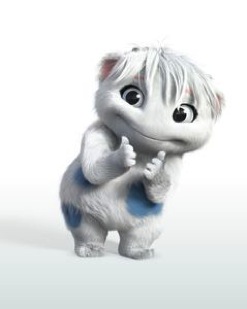
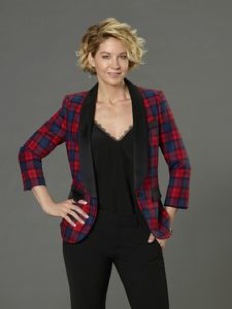
Premiering: Wednesday, March 29th at 7:30 p.m. (central) on ABC before moving to regular Tuesday, 8:30 p.m. slot on April 4th
Starring: Jenna Elfman, Stephen Schneider, Rachel Dratch, Nicholas Coombe, Matreya Scarrwener, Erica Tremblay
Produced by: Adam F. Goldberg, David Guarascio, Doug Robinson
By ED BARK
@unclebarkycom on Twitter
“Better than expected” generally isn’t deemed suitable for a network promotional blurb.
There are mitigating circumstances, though, with ABC’s Imaginary Mary. Its principal punchline-thrower is a sardonic, Pillsbury Doughboy-ish figment voiced by Rachel Dratch. Hmm, that’s a potential recipe for disaster. And the main human star is Jenna Elfman, whose track record charitably has been spotty since she first came to fame two decades ago in ABC’s Dharma & Greg.
Elfman since has sputtered through a raft of failed TV series, including Courting Alex, Accidentally on Purpose, 1600 Penn and Growing Up Fisher. Oof. But here’s another at-bat, with the first two episodes of Imaginary Mary showing some potential. It’s also from the creative team behind The Goldbergs, which is a plus on paper at least.
Back when she was six years old, Alice (played as a grownup by Elfman) became traumatized by her constantly bickering parents’ failed marriage. So she conjured up Mary for emotional support and friendship. But Mary disappeared from her life when Alice became a successful but commitment-phobic career woman. That changes after Alice meets Ben (Stephen Schneider), a divorced dad with principal custody of three children, two of them prototypically problematic teens.
Ben and Alice have been sleeping together for three months. But his kids -- Andy (Nicholas Coombe), Dora (Matreya Scarrwener) and little Bunny (Erica Tremblay) -- still know nothing about their relationship. Isn’t it long past time to clue them in? In pops Mary to suddenly haunt Alice with her now unwanted advice.
“Technically imaginary,” she says in terms of being seen and heard only by Alice. “But to you I’m real as hell and here to stay.”
Mary has a mouth on her, and likes to watch when Alice and Ben are doing it. But the kids initially are a non-starter with “her.” After witnessing their behavior for the first time, she deduces, “OK, the way I see it, these are garbage children.”
Mary regularly encourages heavy drinking as a means of chasing away the blues. “Nothing soothes like ice cold vodka,” she counsels in Episode 2.
This second half-hour, which will be shown in Imaginary Mary’s regular Tuesday slot (after sneak-previewing on Wednesday), also has a shot at Bill Cosby and the first thaws in Alice’s relationships with Ben’s kids. It’s a predictable and inevitable turn, but fairly well-executed. Mary at times disappears rather puzzlingly, though. Perhaps there’s only so much money in the budget for the deft way in which she’s animated.
A couple of months down the road, ABC will launch the like-minded Downward Dog, which co-stars a talking canine opposite Allison Tolman in her first TV series since breaking out in Season One of FX’s Fargo. This makes the network not only the prime home of family comedies, but the place to be for voluble non-humans.
In that context, Imaginary Mary could either pave the way or poison the pond. It seems like a harmless little diversion at this point, with Elfman and Dratch playing well off one another in a fantasy that may have enough winning moments to survive its tough-to-pull-off premise. Then again, ABC couldn’t even keep The Muppets on the air last season. So there’s that, too.
GRADE: B-minus
Email comments or questions to: unclebarky@verizon.net
Despite an already guaranteed Season 2, TV Land's limp Nobodies might just stay that way
03/24/17 02:19 PM
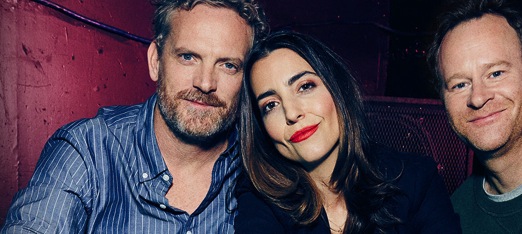
The no ones of Nobodies: Hugh Davidson, Rachel Ramras, Larry Dorf. TV Land photo
Premiering: Wednesday, March 29th at 9 p.m. (central) on TV Land
Starring: Hugh Davidson, Rachel Ramras, Larry Dorf
Produced by: Hugh Davidson, Rachel Ramras, Larry Dorf, Melissa McCarthy, Ben Falcone, Michael McDonald
By ED BARK
@unclebarkycom on Twitter
A trio of real-life Hollywood grovelers all play themselves in TV Land’s Nobodies, which can be desperately amusing at times but too often comes off as just desperate.
Not that it matters what a TV critic might think. Months before the Wednesday, March 29th premiere of its first season, TV Land ordered a 12-episode Season 2 of Nobodies. It doesn’t hurt, of course, when the co-executive producers include Melissa McCarthy and her husband, Ben Falcone, along with the series’ three Brand X stars.
McCarthy and Falcone also pop in and out as themselves, as do the likes of Jason Bateman, Kristen Wiig, Allison Janney, Maya Rudolph, Bob Odenkirk and Kristen Bell.
Still, the first five episodes made available for review are underwhelming and under-achieving. The misadventures of Hugh Davidson, Rachel Ramras and Larry Dorf consistently come off as too slight to carry their weight. Languishing as writers on a fictional animated Nickelodeon show called The Fartlemans, they yearn to be taken seriously and think they have just the right vehicle with their screenplay for Mr. First Lady. But repeated roadblocks and seeming dead ends conspire against them while McCarthy’s potential participation, with Falcone in the title role, keep the trio’s flickering hopes alive. After a while it gets more than a little tiresome.
Dorf is particularly off-putting as a madcap, over-the-top, hopefully in large part fictional version of himself. Otherwise, who in their right mind would work with this guy, let alone be his friend? Yet he’s somehow been married for 11 years in addition to forging a union with Davidson and Ramras.
Davidson tends to be the voice of reason while frazzled single mom Ramras, whose ex-husband now has a gay lover, gets very messily drunk in Episodes 2 and 5. When not aggravating each other or continuing to pitch Mr. First Lady, the three of them hang out at The Groundings comedy club as hapless second-raters to the likes of Rudolph (Episode 1) and Wiig (Episode 5). Dorf has so aggravated Wiig that she tells him he’d be the perfect host -- and winner -- of her fake-proposed Buttholes reality series. Too much of the humor in Nobodies tends to be tied to the anal cavity. But at least there’s a logical sponsor tie-in, namely Gas X.
It’s hard to envision Nobodies sustaining itself for even one season, let alone another one. The bumbling efforts to make Mr. First Lady a fame-and-fortune feature film already seem played out after just the first few episodes.
“I laughed my itty bitty nuts off reading your movie,” Falcone says gamely in Episode 3. Good for him, but seldom the case for the rest of us.
GRADE: C
Email comments or questions to: unclebarky@verizon.net
Hulu's Harlots bares 18th century England
03/23/17 01:34 PM
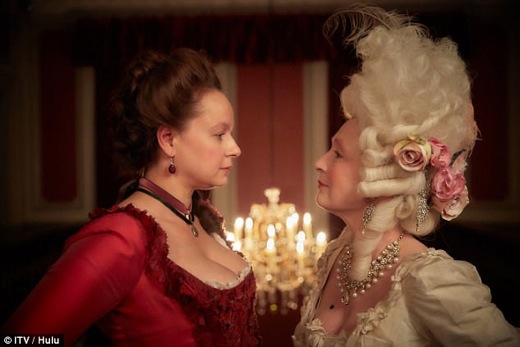
Premiering: begins streaming Wednesday, March 29th on Hulu
Starring: Samantha Morton, Lesley Manville, Jessica Brown Findlay, Eloise Smith, Holli Dempsey, Douggie McMeekin, Hugh Skinner, Daniel Sapani
Produced by: Moira Buffini, Alison Newman, Alison Owen, Alison Carpenter, Debra Hayward
By ED BARK
@unclebarkycom on Twitter
Created, executive produced, written and directed entirely by women, Hulu’s Harlots is an equal opportunity flesh-barer with a not so underlying message.
The fleeting glimpses of women’s exposed breasts and men’s unadorned buttocks are doled out evenly. But in 1763 England, it’s otherwise very much a man’s world, with the rampant “objectification” of women a running thread of this cheeky eight-hour drama series. (Just as a reminder, Hulu doles out just one episode per week rather than taking the whole-season-at-once tacts of Netflix and Amazon Prime.)
Harlots begins by noting that one of every five women made their livings selling sex in these times. So there’s an overriding empathy in play, even if the competition between Madams Margaret Wells (Samantha Morton) and Lydia Quigley (Lesley Manville) is decidedly fierce.
Lydia is the more boo hiss-able. She haughtily runs an upscale brothel with help from her only son, Charles (Dougie McKeekin), a flabby test-driver of new applicants.
Margaret presides over a more ramshackle “boarding house for young ladies” in her words. She has two daughters, seasoned Charlotte (Jessica Brown Findlay) and the still virginal Lucy (Eloise Smith), whose un-flowering could attract some of the big money Margaret needs to relocate to nicer digs. “I’m worth at least 50 pounds, ma,” Lucy is convinced.
Charlotte meanwhile is both stringing along -- and being strung along -- by Sir George Howard (Hugh Skinner), a married, self-absorbed cad of means.
“I’ve ridden hard to be with you,” he tells her before expecting to be satisfied.
“I must ride even harder,” she replies before seeing he’s only brought her a pineapple from his latest travels.
The dialogue occasionally strays into contemporary times. As when ambitious and top-earning Emily Lacey (Eloise Smith) gets dressed down by a fellow prostitute after expressing her disdain for Margaret’s “clucking.”
“Sweet Emily, why don’t you just cluck off?” she’s told. So she does, joining Lydia’s establishment as a further slap at her former boss.
Lydia and Margaret have long despised one another. Their verbal shots can be the stuff of Alexis vs. Krystle from the old ABC serial soap Dynasty.
“I’d like to see Margaret publicly flayed until her back resembles a latticed tart,” Lydia sneers. Margaret returns serve a bit later, getting in Lydia’s face to bellow, “Damn you for a kidnapping pimp!”
Hulu made the first two episodes available for review. They’re beautifully shot, and the costuming also can be sumptuous. Virtually every woman, save for a prototypically tightly wound religious fanatic and her daughter, is preceded by her very accentuated cleavage. The wealthy men of Harlots in turn wear wigs and full makeup while talking dirty and taking what they want. But Margaret’s African-American doorman and enforcer, William North (Daniel Sapani), is a man of decorum who’s also long been her lover. Their 10-year-old son is a “pageboy” at the brothel.
In the early going at least, Charlotte also seems fated to fall for a working class chap who turns the tables and charges her for his so far platonic camaraderie. But the principal character dynamic is the escalating feud between Margaret and Lydia, which heats to a big boil at the end of Episode 2.
Harlots tends to teeter between being a lark and a social tract. The flesh is willing throughout, but the structure can be a little weak. Still, this is a decidedly different and bracing look at ye olde England, with power struggles aplenty as women strive to assert themselves while men mostly just want to insert themselves.
“I’m soft as a rotted fruit,” Sir George protests angrily when his latest coupling goes awry. Story-wise, Harlots sometimes has that problem as well. But more often, it’s a pretty firm carrot.
GRADE: B
Email comments or questions to: unclebarky@verizon.net
Fox's Shots Fired is the latest broadcast network drama aiming to be socially relevant
03/21/17 11:23 AM
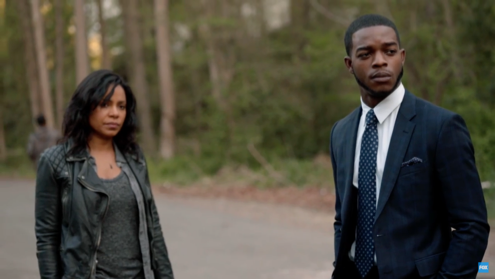
Sanaa Lathan, Stephan James are the driving forces of Shots Fired. Fox photo
Premiering: Wednesday, March 22nd at 7 p.m. (central) on Fox
Starring: Sanaa Lathan, Stephan James, Stephen Moyer, Helen Hunt, Richard Dreyfuss, Mack Wilds, Aisha Hinds, Will Patton, Clare-Hope Ashitey, Conor Leslie, DeWanda Wise, Jill Hennessy, Dennis Haysbert
Produced by: Gina Prince-Blythewood, Reggie Rock Blythewood, Brian Glazer, Francie Calfo
By ED BARK
@unclebarkycom on Twitter
The broadcast networks -- well, at least two of them -- lately have been flexing their social consciences. Not that this is a profitable enterprise.
ABC recently devoted four nights and eight hours to When We Rise, a stirring, affecting dramatization of the LGBT(Q) movement that in this view took the network back to its Roots. But the ratings were hardly Roots-like. In fact, not even remotely close.
Then came the re-launch of American Crime for a third season on ABC. Its core issue this time around is the exploitation of migrant workers. But ratings for the first two episodes have been subterranean.
Now it’s Fox’s turn with Shots Fired, a 10-episode drama that like American Crime is set in North Carolina, but not filmed there. It focuses on the fatal police shootings of two teenagers, one white (by a black cop) and the other black (by a white cop or cops). Predictably, and sometimes rather heavy handedly, the white kid’s death consumes the fictional town of Gate Station while the earlier shooting of the black kid has been covered up and consequently overlooked.
Young prosecutor Preston Terry (Stephan James) and former cop turned investigator Ashe Akino (Sanaa Lathan), both African-American, are called in to probe the case and possibly indict Joshua Beck (Mack Wilds), the only black officer on the force. They also eventually become enmeshed in the shooting of the black teen, whose grieving, justice-seeking mother, Shameeka Campbell (DeWanda Wise), has been ignored by the police and local officials.
A fiery minister, Pastor Janae James (Aisha Hinds), later enters the fray and spurs an escalating “What About Joey?” protest from the black community.
Shots Fired also includes three familiar faces in pivotal supporting roles. Helen Hunt is Gov. Patricia Eamons, outwardly a social justice-seeker, but also in a tough reelection battle. “You make deals to make progress” is one of her mantras.
Richard Dreyfuss plays real estate tycoon and Eamons-backer Arlen Cox, whose latest pet project is a privatized prison. And most effectively of all, Stephen Moyer (True Blood and FX’s recent short-lived The Bastard Executioner, snarls and swaggers as veteran Lt. Calvert Breeland, who’s seen it all and gotten pretty cynical about it. “News flash,” he tells Ashe and Preston in Episode 4. “Profiling works. On white people and on black people.”
Familiar character actor Will Patton chips in as the possibly weaselly town sheriff, Daniel Platt. And Dennis Haysbert can be seen for a few extraneous scenes as the father of Preston and his brother, Mace (Shamier Anderson), a cocksure star player with the Carolina Panthers.
All of these forces intertwine and collide in a morality tale whose soapy touches and swelling music may give Shots Fired a more “commercial” appeal than either When We Rise or American Crime, both of which have more of a documentary feel. While initially battling Preston for her proper share of the turf, the flirty, high-strung, mentally scarred Ashe also is fighting a child custody battle with her ex-. Meanwhile, Preston quickly beds the governor’s top aide, Sarah Ellis (Conor Leslie), and preacher Janae may well have an ulterior agenda based on the person she hops into a car with at the end of Episode 5.
Six of the 10 episodes were made available for review. The evolving story line is involving but can also be over-baked. As is Dreyfuss’ attempted thick suh-thun accent. On the physical appearance front, Hunt is notably stick-thin and very tightly drawn expression-wise -- to the point of being more than a bit disconcerting.
More than halfway through, Shots Fired is still without any indictments while bobbing and weaving through various subplots. Still, it’s drama of a fairly high order and relevancy on a network not known for such efforts. When We Rise and American Crime likely will have bigger upsides come Emmy time. But Shots Fired could be a somewhat bigger audience draw by taking more of a potboiler approach.
GRADE: B
Email comments or questions to: unclebarky@verizon.net
NBC's Trial & Error makes a play date with the "true-crime" genre
03/10/17 02:52 PM
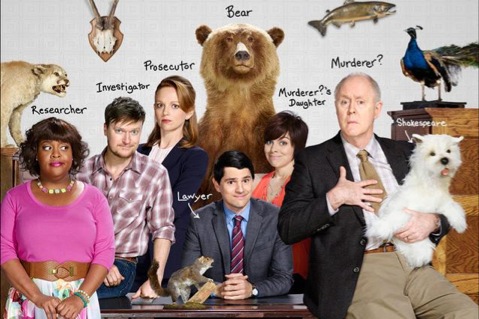
Premiering Tuesday, March 14th at 9 p.m. (central) with back-to-back episodes on NBC
Starring: Nicholas D’Agosto, John Lithgow, Sherri Shepherd, Jayma Mays, Steven Boyer, Krysta Rodriguez
Produced by: Jeff Astrof, Matt Miller, Jeffrey Blitz
By ED BARK
@unclebarkycom on Twitter
There’s no rhyme or reason -- nor is there meant to be -- to this tale of a small town poetry professor charged with fatally propelling his wife through their glass front door.
So the evidence preposterously builds against eccentric Larry Henderson (John Lithgow) in NBC’s Trial & Error, a mockumentary spoof of the burgeoning “true crime” genre. You’ll likely at least be grinning, if not sometimes laughing out loud. Because after a halting start, the amusements are plentiful during the three half-hours made available for review. Back-to-back episodes air each week after Tuesday’s two-pronged premiere following the season finale of This Is Us.
Lithgow’s character is first heard, not seen, making a 911 call in regard to his seriously dead spouse. But he quickly has a higher priority when it appears that another call is incoming from an overdue cable guy. It’s that kind of comedy, something of a cross between The Office and Airplane!.
A green lawyer from New York, Josh Segal (Nicholas D’Agosto), soon arrives in the sub-hamlet of East Peck, South Carolina to represent Larry while assembling an inept team. “Lead investigator” Dwayne Reed (Steven Boyer) can’t be counted on to do anything right. And head researcher/assistant Anne Flatch (Sherri Shepherd) has a wide assortment of oddball disorders, including laughing inappropriately.
They strategize in a back room office located adjacent to a taxidermy shop, which accounts for all of the stuffed animals serving as decor. Larry joins them after being sprung on a seven million dollar bail. Anne -- the poor girl just can’t help herself -- slaps a “Larry Murderer” ID tag on his chest at the start of a brainstorming session. I think that’s when Trial & Error pretty much had me.
Josh’s courtroom nemesis is assistant district attorney Carol Anne Keane (Jayma Mays), who very much wants the top job. She’ll do anything to win a conviction, including attempted seductions. There’s also Larry’s daughter, Summer (Krysta Rodriguez), who likewise has designs on the cute new attorney in town. Local TV anchor/reporter Heidi Baker (Angel Parker) keeps breaking stories that seem to further implicate Larry. In Episode 2, the on-screen subhead reads, “Local Man Accused of Killing Local Wife.”
D’Agosto brings the requisite fresh-faced exasperation to his lead role while Shepherd and Mays are standouts as broadly drawn supporting characters. Lithgow segues from playing Winston Churchill in Netflix’s The Crown to another of his batty comedic turns, which are tailor made for him. Although he did very convincingly play the Trinity Killer in Season 4 of Showtime’s Dexter.
Trial & Error can be hit & miss, but the hits just keep on coming as the murder case twists itself into a pretzel of ifs, buts, maybes and absurdities. This is a show where the trial judge’s nameplate surname is Horsedich, but isn’t pronounced that way. And where the wealthy brother of Larry’s deceased wife proudly notes at the unveiling of her gravestone, “My tobacco company provides a lot of business for this cemetery.”
It’s a decidedly unconventional way to wrap up the last hour of prime-time, which traditionally is stocked with serious-minded crime-and-punishment dramas. On Trial & Error, the defense team’s DNA expert is also a “compulsive masturbator.” Let’s see how this all plays out.
GRADE: B
Email comments or questions to: unclebarky@verizon.net
Opposite of escapism: Season 3 of ABC's American Crime
03/09/17 02:33 PM
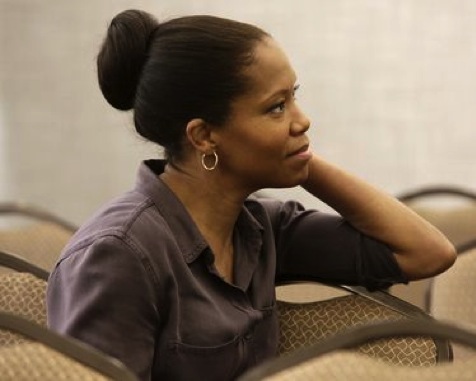
Regina King again is a standout in grim Season 3 of American Crime. ABC photo
By ED BARK
@unclebarkycom on Twitter
Season 3 of American Crime looks like a very tough, if not an impossible sell.
Which in its own way is commendable on the part of ABC but not exactly heartening news for the Disney-owned network’s sales force or stockholders. Broadcast networks generally are loathe to present a decidedly “non-commercial” venture. But ABC lately stands alone in this respect after a substantial and likely anticipated ratings shortfall for last week’s When We Rise, a four-night, eight-hour miniseries that dramatized the history of the LGBT(Q) movement.
Created by John Ridley (12 Years A Slave), American Crime ended up being pretty much a ratings loss-leader in its first two seasons. But the series also deservedly received widespread acclaim for its autopsy-like dissections of race, class, gender and sexual preference. This season (launching on Sunday, March 12th at 9 p.m. central) is the starkest and grimmest yet with its depictions of migrant worker and teen girl trafficking. So don’t anticipate any “entertainment value” if you’re among the many who view television first and foremost as an escape mechanism, not a teaching tool.
American Crime continues to draw on the model of FX’s American Horror Story, with a core repertory company returning in entirely different roles. Principal charter cast members Felicity Huffman, Timothy Hutton and Regina King are all back, as are Benito Martinez, Lili Taylor and Richard Cabral. Another notable returnee, Connor Jessup, joined American Crime in Season 2, and is back as another tragic, anchor-less teen.
Season 3 has been downsized to eight episodes, with filming shifting to Los Angeles after the first two installment were produced in Austin but respectively set in California and Indiana. This time out, L.A. is a stand-in for North Carolina, which currently is being shunned by Hollywood, major music artists and pro sports leagues for its divisive transgender bathroom law.
ABC made Season 3’s initial four episodes available for review. King, who won supporting actress Emmys in each of the first two seasons, is the first major presence as social worker Kimara Walters. She’s hard-pressed to either pay her cable bill or persuade recalcitrant teens that she can help them. Case in point: 17-year-old Shae Reese (Ana Mulvoy-Ten), who still clings to her pimp and also again is pregnant with an unwanted child. Kimara, on the other hand, longs to be a mother but remains barren in her 40s. Expect these twains to inevitably meet, although they haven’t yet by the end of Episode 4.
A companion storyline centers on Luis Salazar (Martinez), who’s smuggled into North Carolina and soon is picking tomatoes for Hesby Farms. But Salazar’s primary objective is finding his missing 17-year-old son, Teo. Meanwhile, Hesby Farms matriarch Laurie Ann Hesby (Cherry Jones) is facing higher costs and diminished profits. She demands even cheaper labor, with the already underpaid pickers living in unfit-for-human-habitation trailer homes prone to flash fires.
Huffman plays Laurie’s daughter-in-law, Jeanette Hesby, who’s long looked the other way but is increasingly guilt-ridden. Her husband, Carson (Dallas Roberts), keeps telling her to back off while another family member, JD Hesby (Tim DeKay), has turned to heavy drinking to ease his conscience.
Jessup is Coy Henson, an aimless drug addict who falls prey to the recruiting techniques of Isaac Castillo (Cabral). Hutton and Taylor are out of the picture until Episode 4, when they first appear as husband and wife Nicholas and Clair Coates. His moneymaking furniture company also has fallen on hard times of late. Making ends meet in a deteriorating economy is a recurring theme this season.
American Crime goes about this oft-dreary business in stark, spare fashion with only scant use of mood music and repeated use of subtitles during the migrant worker segments. Martinez, former co-star of The Shield, contributes the most poignant and affecting characterization as an increasingly desperately seeking father. King and Jessup also are first-rate as expected while the accomplished Huffman’s Jeanette is slower to percolate but eventually gets there.
A great majority of potential viewers no doubt will pass on all of this, which is perfectly understandable. But let the record show that ABC rather amazingly has dared to get behind American Crime for a third time while its Big Four broadcast network rivals -- CBS, Fox and NBC -- perhaps would sooner subject themselves to medieval torturing. So as with When We Rise, applause, applause -- even if it sometimes feels like one hand clapping.
GRADE: A-minus
Email comments or questions to: unclebarky@verizon.net
Patsy Cline gets an overdue American Masters tribute
03/07/17 12:01 PM
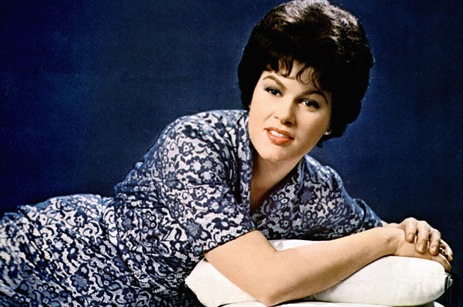
By ED BARK
@unclebarkycom on Twitter
The American Masters’ appreciation of Patsy Cline brings to mind an all too lengthy list of music stars whose careers were cut short by fatal airplane or helicopter crashes.
Otis Redding. Buddy Holly. Rick Nelson. Stevie Ray Vaughn. John Denver. The Big Bopper. Richie Valens. Lynyrd Skynyrd members Ronnie Van Zant and Steve Gaines. Jim Croce.
Cline met that fate on March 5, 1963 after performing in a benefit concert for the family of deceased disc jockey “Cactus” Jack Call. At age 30 she was just getting started, but had recorded timeless hits such as “Crazy, I Fall to Pieces,” and “Walkin’ After Midnight.” Another chart-topper, “Sweet Dreams,” was released after her death.
Narrated by Roseanne Cash, the one-hour American Masters presentation (Wednesday, March 8th at 7 p.m. on KERA13 in Dallas) fittingly is being paired with another reprise of Roy Orbison: A Black and White Night during the PBS station’s latest pledge drive. Both had soaring, piercing and inimitable voices. One could feel their hearts breaking -- or so it seemed -- while they wailed their most memorable ballads. “I fall to pieces each time I see you again. I fall to pieces. How can I just be your friend?”
Cline’s life is recalled in straightforward, workmanlike fashion. The title is simply Patsy Cline without any further add-on. What’s surprising is the ample footage available of her television performances, several of which are replayed at considerable length. This somewhat compensates for the absence of even a single recorded Q & A with the woman born Virginia Patterson Hensley.
Reba McEntire, who contributes a new interview, chortles after saying, “Her voice was strong. Her attitude was strong. And I wouldn’t want to go against her in any way.”
Cline was married twice, briefly to contractor Gerald Cline and then, until her death, to linotype operator Charlie Dick, who died in 2015 and is seen frequently in an archival interview.
The 1985 feature film, Sweet Dreams, controversially depicted their marriage as abusive, mostly on his part. Dick, played by Ed Harris in the movie, labeled it “fiction” at the time. Jessica Lange received an Oscar nomination as Cline. And in a clip shown in the American Masters bio, the late Jerry Haynes (longtime star of Dallas-based WFAA8’s Mr. Peppermint children’s show), can be seen in the role of Cline’s record producer, Owen Bradley.
Lange doesn’t participate in the PBS film. Willie Nelson, who wrote Crazy for Cline, is seen only briefly in archival footage.
She first came to national prominence on a 1957 edition of TV’s Arthur Godfrey’s Talent Scouts, which was hugely influential at the time as a primitive prelude of sorts to American Idol. Cline’s mother, Hilda, introduced her to Godfrey without identifying herself as such. She then performed “Walkin’ After Midnight” and received a big ovation from the audience before Godfrey stepped in to tell her, “Don’t go away, Patsy, honey. You done won this.”
But a restrictive contract with 4 Star Records, which paid her pennies on the dollar and stuck Cline with a series of mostly junk songs, kept her from flourishing until she finally completed her obligations. Bradley and her new agent, Randy Hughes, then helped to take her to the top.
A serious 1961 car wreck put Cline in the hospital for a month just as “I Fall to Pieces” hit it big. Then came “Crazy.” And who knows how many other hits would have followed had she not boarded that plane with Hughes as its pilot? It crashed in bad weather while they were en route to her home in Nashville.
Cline became a star in times when women struggled to gain footholds in a recording industry dominated by male powerbrokers. Patsy Cline portrays her as both independent-minded and also insecure in breaking away from the traditional country music mold and those cowgirl outfits her mother used to make for her early stage performances.
In 1973, Cline became the first solo woman artist to be inducted into the Country Music Hall of Fame. Her most enduring songs have been covered by the likes of LeAnn Rimes, Mickey Guyton and Rhiannon Giddens, all of whom newly extoll her in the American Masters film.
In the end -- and it’s certainly a tragic end -- Patsy Cline is a serviceable but not particularly exceptional presentation. It seems that she’ll always be an artist who deserved and still deserves better. But at least she’s finally on the American Masters map -- some 54 years after she had only just begun.
GRADE: B+
Email comments or questions to: unclebarky@verizon.net
Season 5 of FX's The Americans is still in the Reagan White House era, but what if someday . . .
03/06/17 02:46 PM
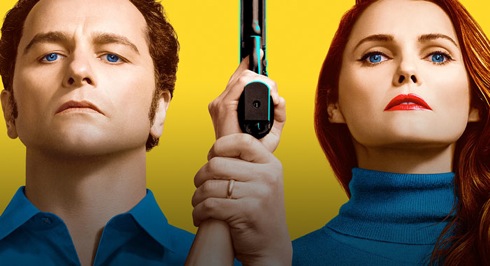
Eyes on the spies: Matthew Rhys and, Keri Russell in The Americans. FX photo
By ED BARK
@unclebarkycom on Twitter
Season 5 of FX’s The Americans remains set in the 1980s, specifically George Orwell’s 1984 at this point.
Since TV time traveling’s in vogue, though, how about fast-forwarding Russian spies Elizabeth and Philip Jennings (Keri Russell, Matthew Rhys) to a reasonable facsimile of “Trump World? for a “very special” final season? Think of what they might accomplish. And no, this is not an entirely facetious suggestion down the road.
The Americans otherwise remains in the top tier of TV dramas, even if the first three episodes of the 13-episode new season (launching Tuesday, March 7th at 9 p.m. central) could use a kick in the pants pacing-wise. If you haven’t yet discovered the show, this probably isn’t an ideal entry point. The key event near the end of the fifth season’s opening hour seems to take forever and a day to unfold. I’m all for building suspense, but one also has to be careful not let the air out.
It all restarts with Philip and Elizabeth under cover again, this time assisted by a teenage Vietnam refugee posing as their adopted son. Meanwhile, their biological daughter, Paige (Holly Taylor), continues to feel controlled and unfulfilled after finding out last season who her parents really are. Her budding romance with the neighboring Matthew (Daniel Flaherty), son of spy-hunting FBI agent Stan Beeman (Noah Emmerich), continues to deeply disturb Elizabeth and Philip. What if she slips and blurts something out in the throes of passion?
The Jennings’ other child, Henry (Keidrich Sellati), seemingly has become a virtual non-entity. He’s glimpsed just once, early in Episode 1. It’s just enough to show that the actor playing him clearly has undergone a growth spurt.
These opening three episodes also spend considerable time in the Soviet Union, where Oleg Igorevich Burov (Costa Ronin) has returned and been enlisted by the KGB. No one in his homeland yet suspects that he became Beeman’s go-between. But now the CIA wants to blackmail him into playing ball again despite Beeman’s best efforts to act on his behalf.
Not to give away too much, but there’s also an allegedly sinister plan afoot involving U.S. grain shipments to the Soviet Union. Getting to its roots becomes Elizabeth’s and Philip’s principal undercover objective. Their longtime Soviet handlers, Gabriel and Claudia (Frank Langella, Margo Martindale), are sprinkled in only briefly in the three episodes made available for review. They do have a blunt-spoken, telling exchange, though, in Episode 1.
“Noting scares those two,” Claudia says of Elizabeth and Philip.
“Everything scares those two,” he retorts.
There’s also an even briefer sighting of a memorable supporting character. You’ll have to wait until Episode 3, though.
FX is planning just one more season of The Americans beyond this one. The series continues to challenge the perceptions of viewers with alternately sympathetic and ruthless portrayals of Philip and Elizabeth. Her heart is hard when necessary. At one point, Paige’s lament that it “felt gross” to lie to Matthew is countered by Elizabeth’s matter-of-fact rationale that “being in a relationship is complicated. You don’t share everything. You hold back what you need to. Everybody does.”
Continued cold-blooded killing continues to be one of the hold-backs from Paige, with relatively innocent victims merely part of the collateral damage.
Season 5 of The Americans almost assuredly will round into form after a rather sluggish start compared to previous returns. In the initial three hours, the plot both thickens and sometimes congeals. What an electric avenue it could be, though, if a grizzled but thoroughly wily Elizabeth and Philip jetted roughly three decades into the future for their ultimate mission in Season 6. Yeah, that’s extremely unlikely to fly. But oh how I’d love to see them give it a whirl.
GRADE: B+
Email comments or questions to: unclebarky@verizon.net
Time travel palooza with Fox's Making History and ABC's Time After Time
03/03/17 02:12 PM
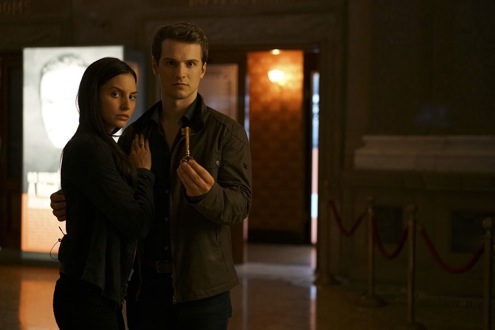
Premiering: Sunday, March 5th at 8 p.m. (central) on ABC
Starring: Freddie Stroma, Josh Bowman, Genesis Rodriguez, Nicole Ari Parker, Will Chase, Jennifer Ferrin
Produced by: Kevin Williamson, Marcos Siega
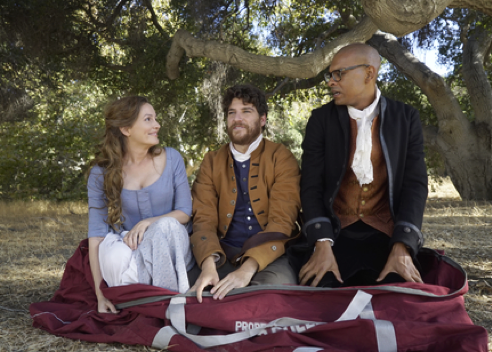
Premiering: Sunday, March 5th at 7:30 p.m. (central) on Fox
Starring: Leighton Meester, Adam Pally, Yassir Lester
Produced by: Phil Lord, Chris Miller, Jared Hess, Seth Cohen, Julius Sharpe
By ED BARK
@unclebarkycom on Twitter
One’s deadly serious, the other purely farcical.
They simultaneously hit Sundays shortly after NBC’s Timeless had its season and possibly series finale in late February.
A little traveling music please. All three series jaunt back and forth in time, one via an oversized red duffel bag. That would be Fox’s new Making History, a surprisingly bright and amusing half-hour comedy that easily could have gone very wrong.
Dan Chambers (Adam Pally) is a rather dim bulb maintenance man employed at Lexington, MA’s Bedford College. But he’s heroic, dashing, poetic and thoroughly visionary in the eyes of Paul Revere’s daughter, Deborah (Leighton Meester). In reality, Dan just knows how to recycle.
“Deborah, you complete me. You had me at hello,” he tells her in Sunday’s first episode. Swoon.
Traveling in a zippered, internally wired device perfected by his late father, Dan regularly hooks up with Deborah during his journeys back to 1775 Lexington, where the men are coarse chauvinists and the British remain an occupying army. Stay with me.
Dan’s wingman ends up being high strung history professor Chris Parish (Yassir Lester), who loves the colonial period and is aghast that the Revolution for some reason is behind schedule. So he joins Dan in hopes of giving things a jump start. Gag, Lexington has a very foul air to it because of all the manure on the ground. And since vomiting scenes are still epidemic on today’s TV, you’ll have to get past another unnecessary one before Making History stars to hit its stride.
Episode 2 remains in Lexington, with much of its humor triggered by America’s long and enduring relationship with guns. Founding Fathers John Hancock and John Adams (John Gemberling, Neil Casey) are portrayed as dolts who spend most of their time drinking in Buckman Tavern while blacksmith Paul Revere is a humorless taskmaster who basically views his daughter as a hired hand living under his thumb.
A pair of subsequent half-hours sent for review take the time traveling to 1919 Chicago, where Dan, Chris and Deborah hope to win enough money to open her dream ice cream parlor in present-day Lexington. An easy way to do this, it seems, would be to make a big bet on the underdog Cincinnati Reds in their rigged World Series matchup with the Chicago White Sox. Instead they run afoul of Al Capone (Tim Robinson), who turns out to be a good deal of fun in his own slam-bang way.
Making History doesn’t get everything right. But the series’ principal trio commit themselves fully, with Meester particularly fresh and appealing as a transplanted colonial having the time of her life as a newly liberated woman.
The casting likewise is strong in ABC’s Time After Time, based on the same-named 1979 feature film fronted by Malcolm McDowell, David Warner and Mary Steenburgen.
In this case, H.G. Welles (Freddie Stroma) is the fresh-faced babe in the woods, or deer in the headlights if you prefer. He’s an idealist who’s convinced that the distant future will be a blissful utopia compared to 1893 London, where the drama begins.
One of Welles’ close friends, Dr. Jack Stevenson (Josh Bowman), knows whereof he speaks when he says that mankind will never change. “We’re animals. We hunt. We’re hunted,” he tells Welles after returning from a fresh kill in his secret guise as the slasher dubbed Jack the Ripper.
Scotland Yard is in hot pursuit this time, though. And the bloody implements of Stevenson’s deed are found in his briefcase. This prompts a hasty escape -- to 2017 New York City as it turns out -- in Welles’ still untested time machine. When it returns to 1893, Welles gets aboard and pursues Stevenson after seeing the date and year for which the machine was set. He carries with him a “non-return key” that keeps the contraption in place. Otherwise it returns from whence it came, which is why Welles was able to chase Stevenson. Again, stay with me.
Time After Time’s third wheel is comely assistant museum curator Jane Walker (Genesis Rodriguez), who lives alone and has been unlucky in love. The budding relationship between the gentlemanly Welles and the skeptical but smitten Walker is nicely played against all the overriding life and death drama. Complicating things is the suspicious emergence of Vanessa Anders (Nicole Ari Parker), who says she’s Welles’ great great granddaughter.
The series’ principal executive producer, Kevin Williamson, has a longstanding taste for slasher films (Scream, I Know What You Last Summer) and serial killers (Fox’s The Following and CBS’ critically reviled Stalker). He tamps down the gore in the first two episodes of Time After Time (airing back-to-back Sunday night). But the violence toward women is still palpable, with Stevenson thrilled to be fast-forwarded to a world that’s immediately depicted as far more violent than the one he came from.
“I belong here completely,” he says. Welles is his polar opposite. “There will be no violence,” he protests when the Texas-raised Jane gives him her pistol. “The man who raises his fist first is the man out of ideas.”
Time After Time may well have trouble sustaining itself, given all of the near misses and constant escapes in just the first two episodes. Williamson still seems to perversely enjoy putting women in harm’s way, with both Jane and a gagged, terrified Macy’s employee being held hostage for much of Hour 2.
It’s at least an improvement over Stalker, though, and in reality what wouldn’t be? Stroma and Rodriguez have some sweet getting-to-know-you moments together while Bowman has presence as a menace run amuck. Still, by the end of Episode 2, a dull-edged redundancy is already starting to set in.
GRADES
Making History -- B
Time After Time -- C+
FX's Feud: Bette and Joan gives old Hollywood a big and boisterous tumble
03/02/17 02:37 PM
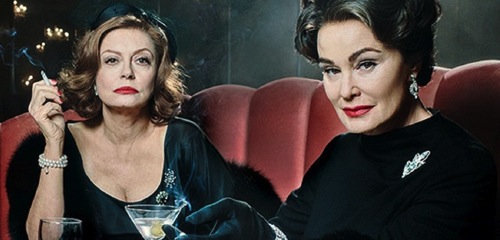
Premiering: Sunday, March 5th at 9 p.m. (central) on FX
Starring: Jessica Lange, Susan Sarandon, Alfred Molina, Stanley Tucci, Judy Davis, Jackie Hoffman, Alison Wright, Catherine Zeta-Jones, Kathy Bates, Kiernan Shipka, Dominic Burgess
Produced by: Ryan Murphy, Dede Gardner, Tim Minear, Alexis Martin Woodall
By ED BARK
@unclebarkycom on Twitter
Old-line show biz hasn’t been this delectable since HBO went to town on Liberace in 2013’s Behind the Candelabra.
FX’s eight-part Feud: Bette and Joan also can be substantive in telling the tale of two larger-than-life, but fading dynamos battling the Hollywood system in times when women were very seldom seen behind the camera and discarded when they were deemed too old to be in front of it. Not that it ever gets too preachy. But with Susan Sarandon and Jessica Lange in the roles of Bette Davis and Joan Crawford, this is much more than a campy romp in the mode of Mommie Dearest. Then again, many of the lines and situations are to die for, darlings. There’s simply no way to ever get bored, unless you’re the type who can nap on a roller coaster.
At the helm is Ryan Murphy, the reigning FX golden boy behind The People v. O. J. Simpson: American Crime Story and the American Horror Story franchise. Before Bette and Joan even airs, FX has ordered a second installment titled Feud: Charles and Diana.
Bette and Joan, for which the first five, one-hour parts were made available for review, is built around the pairing of Davis and Crawford in the wholly unanticipated smash feature film of 1962, What Ever Happened to Baby Jane? Both Oscar-winning actress were in their 50s and already seen as unbankable by then. But Crawford’s search for renewed fame and above all, respectability, smolders like the cigarettes she dragged on between swills of straight booze from a flask or martini glass. So with help from her devoted, Lotte Lenya-esque “Mamacita” (a growingly impressive turn by Jackie Hoffman), she doggedly seeks the right vehicle and a pliant director after barely surviving a suitably breathy Marilyn Monroe at the 1961 Golden Globe awards.
Baby Jane, a pulp psychological thriller written by Henry Farrell, centers on former child star Baby Jane Hudson, who’s now haggard, demonic and determined to make her paralyzed sister, Blanche, miserable in the rundown mansion they share. Although supremely jealous of Davis and the acclaim heaped on her, Crawford figures they can restore each other’s powers.
“No one’s looking to cast women our age,” she tells Bette in her dressing room after another long night as window dressing in Night of the Iguana. “But together, they wouldn’t dare say no. We need each other, Bette.”
They also need a director willing to go along, and find one in Robert Aldrich (Alfred Molina), a big-dreaming shlepper under the thumb of studio boss Jack Warner (Stanley Tucci). And so these very uneasy alliances are born.
Bette and Joan also deftly weaves in cutthroat gossip columnist Hedda Hopper (Judy Davis), who never met a star she couldn’t intimidate or manipulate. “Welcome to the house that fear built,” she says deliciously before Davis and Crawford stride in for what’s meant to be a lavish dinner.
Less successfully integrated are Olivia de Havilland (Catherine Zeta-Jones) and Joan Blondell (Kathy Bates), who periodically pop up to recount the lives and times of Crawford and Davis while being interviewed, circa 1978, at the Dorothy Chandler Pavilion. Although catty in their own rights, they’re also the ad hoc feminists of Bette and Joan. The box office success and critical acclaim for Baby Jane would have vaulted aging actors back into prominence, they lament. But as aging actresses, Davis and Crawford weren’t afforded such career bounces. These interludes sometimes come off a bit too much like sandwich boards. We pause now for a word from our social consciences.
The walkup to, and the making of Baby Jane, are dramatized in the first three parts. Warner loves what he’s seeing in the dailies, and demands that the pliant but guilt-ridden Aldrich keep Crawford and Davis at each other’s throats in order to add extra invective to their performances. He doesn’t have to work that hard at it. “They’re not getting along. They’re teaming up. It’s like the Hitler-Stalin pact,” Aldrich tells his neglected wife.
The director’s loyal assistant, Pauline Jameson (Alison Wright from The Americans), tries to keep him on track while also yearning to make movies herself. But Crawford emphatically shatters this dream, at least temporarily, in a Part 4 that otherwise belongs largely to Molina as Aldrich in the best role he’s had since . . . well, maybe ever. This is also the one where Frank Sinatra (Toby Huss) can be glimpsed as a crude, cruel, condescending jerk during the course of refusing to cooperate with Aldrich on the set of his followup film, 4 For Texas. Kiernan Shipka of Mad Men fame, who plays Davis’ chafing teen daughter, “B.D.,” gets little to do until Part 3. Crawford’s strictly disciplined, comparatively well-mannered twin daughters, Cindy and Cathy (Brooke Star, Chelsea Summer), are warned to stay away from her.
Part 5, which culminates at the 1963 Oscars ceremony, is a paradise of scheming and counter-scheming. Crawford’s the main instigator after Davis is nominated for an Academy Award and she’s not. Almost desperately hoping to make history by becoming the first actress to win three Oscars, Davis tells the two she already has to “wait up for me, boys. Tonight I’m bringing you home a baby brother.” But Crawford ends up cannily stealing the show in ways that are both incredible -- and absolutely true.
Bette and Joan is amazingly and ironically on point when Crawford first goes to see Academy president Wendell Corey (uncredited) to inform him she fully intends to be a presenter. He initially thinks she’s there to protest being left out of the Best Actress field. “Joan, I can promise you, the vote tally is beyond reproach,” he says. “The people at Price Waterhouse are honest to a fault.” But as the world learned last Sunday, not terribly careful.
Lange and Sarandon, as did Crawford and Davis, both have Best Actress Oscars on their mantels -- or somewhere. Lange also has won two Emmys for different roles in Murphy’s ongoing American Horror Story while Sarandon is working with him for the first time. Their performances in Bette and Joan are impeccable, with Lange getting the best of it in the early going before Sarandon fully registers after making herself over into the garish and mad Baby Jane. By Part 3, their brief detente during an extended off-set drinking scene serves as a case study in how to play off one another.
Bette and Joan also exercises advertiser-supported FX’s latter day penchant for f-bombs in the interest of stark realism. Davis’ kiss-off to the William Morris Agency is perfectly apt in this context. A facsimile such as “Screw you” just wouldn’t suffice.
While Baby Jane makes beautiful music at the box office, Davis is still getting no better offers than a featured role on Perry Mason. Although it’s not made clear, this actually happened when the show’s star, Raymond Burr, was hospitalized in real-life.
“It’s television,” Davis snorts to Aldrich.
“There’s no shame in doing television,” he insists.
Perhaps there was then, but there certainly isn’t now. FX lately is almost singlehandedly making TV the place to be for adventuresome performers young, old and in-between. Bette and Joan gives Lange and Sarandon a sublime showcase from the first moment they hit their marks. So why not give the ol’ “eff you” to the big screen and keep feasting on what TV or streamers such as Netflix or Amazon have to offer?
The old dictatorial Hollywood film studios offer plenty of irresistible drama and melodrama, which Bette and Joan exploits with a furious vengeance at times. Increasingly, smaller screens are where it’s at. And that shouldn’t really be a revelation anymore.
GRADE: A-minus
Email comments or questions to: unclebarky@verizon.net
